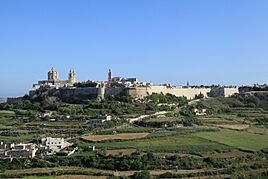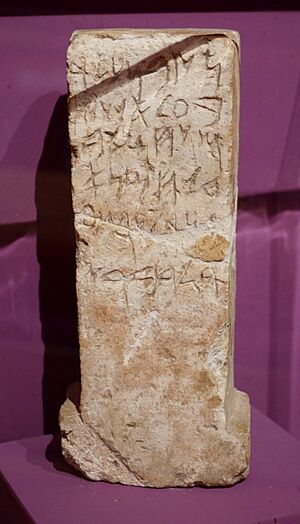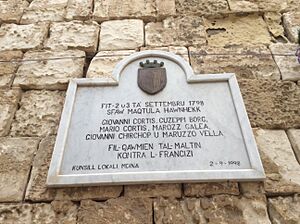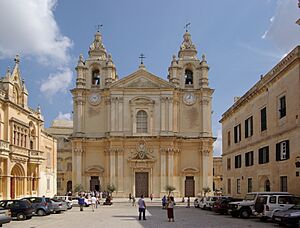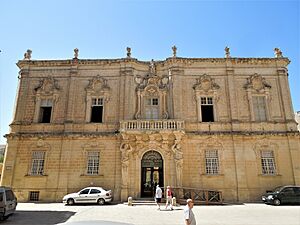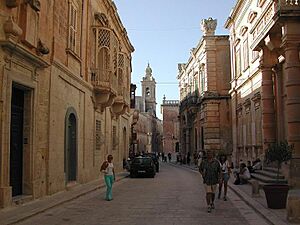Mdina facts for kids
Quick facts for kids
Mdina
L-Imdina (Maltese)
Città Notabile, Città Vecchia
Ann, Melite, Melita |
|||
|---|---|---|---|
|
City and Local council
|
|||
|
From top: Skyline, Cathedral, Main Gate, Palazzo Santa Sofia, Palazzo Vilhena
|
|||
|
|||
| Nickname(s):
The Silent City
|
|||
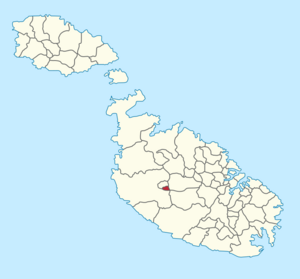 |
|||
| Country | |||
| Region | Northern Region | ||
| District | Western District | ||
| Established | c. 8th century BC as Ann c. 11th century AD as Mdina |
||
| Borders | Attard, Mtarfa, Rabat | ||
| Area | |||
| • Total | 0.9 km2 (0.3 sq mi) | ||
| Population
(Aug. 2023)
|
|||
| • Total | 93 | ||
| • Density | 103/km2 (268/sq mi) | ||
| Demonym(s) | Midjan (m), Midjana (f), Midjani (pl) | ||
| Time zone | UTC+1 (CET) | ||
| • Summer (DST) | UTC+2 (CEST) | ||
| Postal code |
MDN
|
||
| Dialing code | 356 | ||
| ISO 3166 code | MT-29 | ||
| Patron saints | St. Peter St. Paul Our Lady of Mount Carmel |
||
| Day of festa | 29 June 4th Sunday of July |
||
| Buses 50, 51, 52, 53, 56 from Valletta terminus, stop at bus stop named "Rabat 3" | |||
Mdina (Maltese: L-Imdina), also called the Old City or Notable City, is a fortified city in Malta. It used to be the island's capital for a very long time, from ancient times until the medieval period.
The city is still surrounded by its old walls. It has a small population of about 93 people. Mdina is right next to the town of Rabat, which means "suburb" in Arabic. Rabat has over 11,000 people.
Mdina is built on a high, naturally protected area. People have lived here since prehistoric times. Around the 8th century BC, the Phoenicians built a settlement called Ann. Later, the Romans took over and renamed it Melita. This Roman city was much bigger than today's Mdina.
The city became smaller during the time of Byzantine or Arab rule. After a big event in the 9th century, the area was mostly empty. It was rebuilt in the 11th century and called Madīnah, which is where the name Mdina comes from.
Mdina stayed the capital of Malta until 1530. That's when the Knights of St. John arrived and chose Birgu as their new capital. Mdina then became less important. However, in the early 1700s, many beautiful Baroque buildings were added.
Today, Mdina still looks much like it did in medieval times. It's known as the "Silent City" because it's so quiet. Mdina is on the list of possible UNESCO World Heritage Sites. It is also one of Malta's most popular places for tourists.
Contents
What's in a Name?
The name Mdina comes from the Arabic word madīnah. This word simply means "town" or "city." The older name Melite or Melita is still used for the island of Malta itself.
Mdina's Past: A Journey Through Time
Ancient Beginnings
The high ground where Mdina stands has been lived on since very old times. By the Bronze Age, it was a safe place because it was easy to defend. The Phoenicians started a settlement here around the 8th century BC. They called it Ann.
The Roman Republic took control of Malta in 218 BC. They kept Mdina as their main city but renamed it Melita. This name came from the Greek and Latin names for the island. The Roman city of Melita was about three times larger than Mdina is today. It stretched into a big part of modern Rabat.
According to the Acts of the Apostles, Paul the Apostle was shipwrecked on Malta in AD 60. The governor, Publius, welcomed him. Paul is said to have healed Publius's sick father. Christian stories say that the people of Malta then became Christians.
Not many parts of the Roman city are left today. The most important ruins are from the Domus Romana. Here, people found amazing mosaics, statues, and other ancient items.
Medieval Times
After the fall of the Western Roman Empire, the city was made smaller. This made it easier to defend. It's thought that the Byzantine Empire might have done this around the 8th century. This was when threats from the Arabs grew.
In 870, the city was attacked by the Aghlabids. The city was destroyed, and its churches were looted. Malta was almost empty until it was settled again in 1048 or 1049 by Muslims from Sicily. They built a new settlement called Madina. This new city had a different layout, with narrow, winding streets. These streets are still seen in Mdina today.
The Byzantines tried to attack Madina in 1053–54, but the city's defenders stopped them. In 1091, the city peacefully gave up to Roger I of Sicily. Malta then became part of the Kingdom of Sicily. A castle called the Castellu di la Chitati was built near the main entrance.
By the 12th century, the city's walls were rebuilt and made bigger. The area outside the walls became a suburb, which is now Rabat. In the 1400s, Mdina was smaller and partly empty. It was already smaller than its suburb, Rabat.
The city survived an attack by invaders in 1429. Many people were taken as slaves during this raid.
The Knights of St. John

When the Order of Saint John came to Malta in 1530, the nobles of Mdina gave them the city's keys. But the Knights chose Birgu as their capital. So, Mdina lost its important status.
In the 1540s, the city's defenses were improved. In 1551, Mdina survived a quick attack by the Ottomans.
During the Great Siege of Malta in 1565, Mdina was a base for the Knights' cavalry. They attacked the Ottoman army from here. This helped the Knights win the siege. After the siege, there were plans to make Mdina even smaller and stronger. But the city's nobles stopped these plans. The walls were improved again in the mid-1600s.
Mdina was badly damaged by an earthquake in 1693. The old Cathedral of St. Paul was partly destroyed. It was rebuilt in the Baroque style between 1697 and 1703.
In 1722, Grand Master António Manoel de Vilhena ordered Mdina to be restored. A French architect, Charles François de Mondion, led this work. He added many French Baroque elements to the city. Parts of the walls and the city entrance were rebuilt. The old castle was taken down to build Palazzo Vilhena. A new main gate, the Mdina Gate, was also built.
French and British Rule
On June 10, 1798, French forces captured Mdina easily. A French army stayed in the city. But a Maltese uprising began on September 2. The next day, rebels entered the city and killed the French soldiers. This started a two-year uprising and blockade. The Maltese rebels set up a National Assembly in Mdina. In 1800, the French gave up, and Malta became a British protectorate.
From 1883 to 1931, Mdina was connected to Valletta by a railway.
Mdina Today
Today, Mdina is a major tourist spot in Malta. About 1.5 million tourists visit each year. Most cars are not allowed in Mdina. This is why it is called 'the Silent City'. The city has a unique mix of Norman and Baroque buildings. Many of its palaces are still private homes.
The city walls were carefully restored between 2008 and 2016.
Places to See in Mdina
Here are some of the historic buildings and places you can visit in Mdina:
- The city walls, including Mdina Gate, Greeks Gate and the Torre dello Standardo
- St. Paul's Cathedral
- St. Paul's Catacombs
- Palazzo Vilhena (which is now the National Museum of Natural History)
- Palazzo Falson (also known as the Norman House)
- Palazzo Santa Sofia
- Banca Giuratale
- Corte Capitanale (the old city hall)
- St. Agatha's Chapel
- St. Nicholas' Chapel
- Carmelite Church & Convent
- Mdina Dungeons
- St Peter's Church and Monastery
- Bastion Square
- Domvs Romana, the ruins of a Roman house just outside the city
Streets to Explore
Mdina has many interesting streets and squares. Here are some of them:
- Misraħ il-Kunsill (Council Square)
- Pjazza San Pawl (St Paul Square)
- Pjazza tas-Sur (Bastion Square)
- Triq Inguanez (Inguanez Street)
- Triq Mesquita (Mesquita Street)
- Triq is-Sur (Bastion Street)
- Triq San Pawl (St Paul Street)
- Triq Villegaignon (Villegaignon Street) (This is the main road).
Famous People from Mdina
- Pietru Caxaro - a philosopher and poet
- Francesco Azopardi - a composer and music expert
- Joseph Calleia - an actor and singer
See also
 In Spanish: Mdina para niños
In Spanish: Mdina para niños


